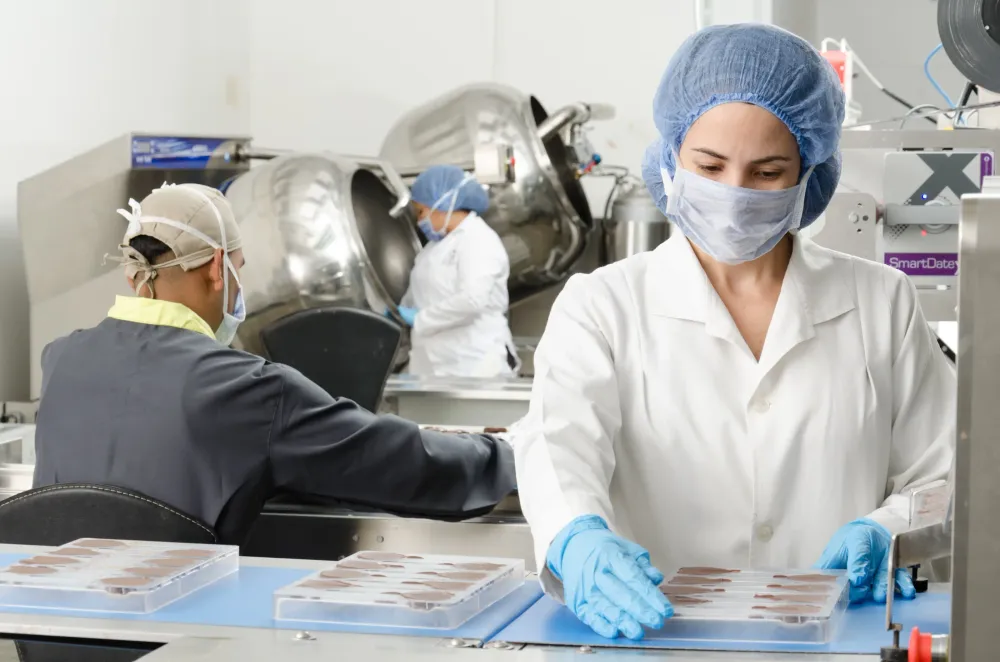Handskar för livsmedelshantering är obligatoriska för att upprätthålla hygienen och förhindra kontaminering inom livsmedelsindustrin. Det är därför viktigt att arbetare bär rätt typ av handskar när de hanterar livsmedel för att förhindra spridning av skadliga bakterier och andra föroreningar.
Att välja rätt typ av handskar kan vara en svår uppgift, eftersom det finns många olika faktorer att ta hänsyn till. I den här guiden gör vi en djupdykning bland alla dessa handskar för att utforska de olika typerna som finns tillgängliga, faktorer att ta hänsyn till när man väljer handskar samt korrekt användning och skötsel av dess produkter.
Vi svarar också på alla vanliga frågor och ger dig en köpguide som kan leda dig till att välja rätt handskar för ditt användningsområde.
Detta kommer du att läsa:
- Typer av handskar för livsmedelshantering
- Inköpsguide till handskar för livsmedelshantering
- Vanliga frågor om handskar för livsmedelshantering

Typer av handskar för livsmedelshantering
Det finns tre huvudtyper av handskar för livsmedelshantering: latex, nitril och vinyl.
Latexhandskar är tillverkade av naturgummi och är kända för sin komfort och flexibilitet. De ger en hög grad av taktil känslighet, vilket gör dem perfekta för arbetsuppgifter som kräver exakta rörelser, till exempel matberedning. Latexhandskar kan dock orsaka allergier hos vissa personer, vilket gör dem olämpliga att använda i vissa miljöer.
Nitrilhandskar är tillverkade av ett syntetiskt gummi som är mer motståndskraftigt mot punktering och revor än latexhandskar. De ger ett högre skydd mot kemikalier och är ett bra alternativ för tunga arbetsuppgifter. Nitrilhandskar är också mindre benägna att orsaka allergier och kan användas i miljöer där latexhandskar inte är lämpliga.
Vinylhandskar är tillverkade av ett syntetiskt material och är det mest prisvärda alternativet. De är bekväma att bära och ger ett bra skydd mot föroreningar. Dock är de även den minst hållbara av de tre typerna och lämpar sig inte för tunga arbetsuppgifter. Du kan läsa mer om vinylhandskar i vårt blogginlägg: Vinylhandskar: den prisvärda lösningen för industrisäkerhet.
Inköpsguide till handskar för livsmedelshantering
För att välja lämpliga handskar för livsmedelshantering är det viktigt att ta hänsyn till de särskilda uppgifter och situationer där de kommer att användas. Beroende på den avsedda användningen kan vissa handskar vara mer lämpliga än andra då de erbjuder olika skyddsnivåer.
Latexhandskar är kända för sin komfort och flexibilitet, vilket gör dem till ett bra val för arbetsuppgifter som kräver en hög grad av fingerfärdighet, t.ex. matberedning och service. Vissa personer kan dock ha latexallergi, så det är viktigt att ta hänsyn till detta när du väljer handskar till din personal. Det är också viktigt att notera att latexhandskar inte rekommenderas för arbetsuppgifter som innebär hantering av feta livsmedel, eftersom fetter kan bryta ner materialet.
Nitrilhandskar är däremot mer motståndskraftiga mot punktering och revor än latexhandskar, vilket gör dem till ett bra alternativ för tyngre uppgifter som kräver extra skydd. De är också ett bättre val för arbetsuppgifter som innebär hantering av vissa kemikalier eller andra farliga material. Se alltid till att välja rätt skyddsnivå för ditt användningsområde, du kan läsa mer om det i vårt blogginlägg: Säkerställa arbetstagarna: hur man väljer rätt personlig skyddsutrustning (PPE). Nitrilhandskar är vanligtvis ganska motståndskraftiga mot lätta punkteringar och revor, vilket gör dem till ett bra val för hantering av rått kött och feta livsmedel. De går även att beställa i olika tjocklekar för att passa uppgiften i fråga.
Vinylhandskar är det mest prisvärda alternativet, men de är också de minst hållbara. De är ett bra val för arbetsuppgifter som inte kräver en hög skyddsnivå, t.ex. hantering av torra eller icke-feta livsmedel. De rekommenderas inte för arbetsuppgifter som innebär hantering av feta livsmedel eller kemikalier.
Förutom typen av handskar är det viktigt att ta hänsyn till handskarnas tjocklek och struktur. Tjockare handskar ger mer skydd mot föroreningar, medan handskar med textur ger mer grepp och kontroll. När man har att göra med kunder eller hanterar livsmedel är det viktigt att välja handskar som är livsmedelssäkra och uppfyller kraven för livsmedelssäkerhet. Läs mer om hur du väljer rätt PPE för ditt specifika användningsområde i vårt blogginlägg: Säkerställa arbetstagarna: hur man väljer rätt personlig skyddsutrustning (PPE).
Värmebeständiga handskar är nödvändiga när du hanterar varma föremål, t.ex. grytor och stekpannor. Dessa handskar är utformade för att tåla olika grader av höga temperaturer och är vanligtvis tillverkade av material som silikon eller neopren. Vissa värmebeständiga handskar för matlagning är också utformade för att ge extra grepp, vilket gör det lättare att hantera hala föremål.
Sist men inte minst är det viktigt att välja handskar som passar ordentligt för att garantera en bekväm och säker passform. Handskar som är för små kan vara obekväma och begränsa rörligheten, medan handskar som är för stora kan vara besvärliga och svåra att arbeta med. Rätt storlek på handskar för livsmedelshantering ger det nödvändiga skyddet utan att äventyra arbetstagarens förmåga att utföra sitt arbete på ett effektivt sätt.

Vanliga frågor om handskar för restaurangtjänster
Här är alla dina vanligaste frågor om handskar för livsmedelshantering:
- Vilka är de olika typerna av handskar för livsmedelshantering? Det finns tre huvudtyper: latex, nitril och vinyl.
- Vilken handskstorlek ska jag använda? För att bestämma rätt handskstorlek ska du mäta bredden på din handflata på den bredaste punkten och konsultera en tabell över handskstorlekar.
- Hur gör jag mig av med handskar på rätt sätt? Begagnade handskar ska kastas i en sluten behållare i din restaurang eller livsmedelsanläggning för att förhindra kontaminering.
- Hur säkerställer jag att handskar inte orsakar korskontaminering? Byt handskar ofta, särskilt när du byter mellan olika typer av livsmedel. Undvik att röra vid ytor som inte har med den aktuella uppgiften att göra.
- Vad är livsmedelshandskar? Livsmedelsklassade handskar är handskar som är utformade för att användas inom livsmedelsindustrin för att förhindra korskontaminering och garantera konsumenternas säkerhet. De är ofta tillverkade av material som är motståndskraftiga mot punktering och som uppfyller kraven för livsmedelssäkerhet.
- Vad är engångshandskar? Engångshandskar är handskar som är utformade för att användas en gång och sedan kastas. De används ofta inom livsmedelsindustrin för att förhindra korskontaminering.
- Vad är skyddshandskar? Skyddshandskar är handskar som är utformade för att skydda bäraren från potentiella faror, t.ex. kemikalier, bakterier eller skärsår.
- Vad är kökshandskar? Kökshandskar är handskar som är utformade speciellt för användning i köket. De är ofta tillverkade av värmebeständiga material för att skydda bäraren från brännskador och är utformade för att ge ett säkert grepp när man hanterar heta eller hala föremål.

Slutsats
Handskar för livsmedelshantering är en viktig del av livsmedelssäkerheten och hygienen i alla restaurangkök eller anläggningar för livsmedelsproduktion.
Genom att välja rätt handskar för dina användningsområden och följa rätt riktlinjer för användning och skötsel kan du förebygga kontaminering och garantera säkerheten för både dina anställda och de personer som konsumerar dina produkter.
Vi förstår vikten av handskydd i professionella miljöer, och erbjuder därför ett brett urval av handskar för livsmedelshantering från betrodda europeiska leverantörer.
Ta en titt på vår omfattande katalog över livsmedelshandskar från Europas främsta tillverkare och upplev kvaliteten själv genom att beställa ett gratisprov.

















